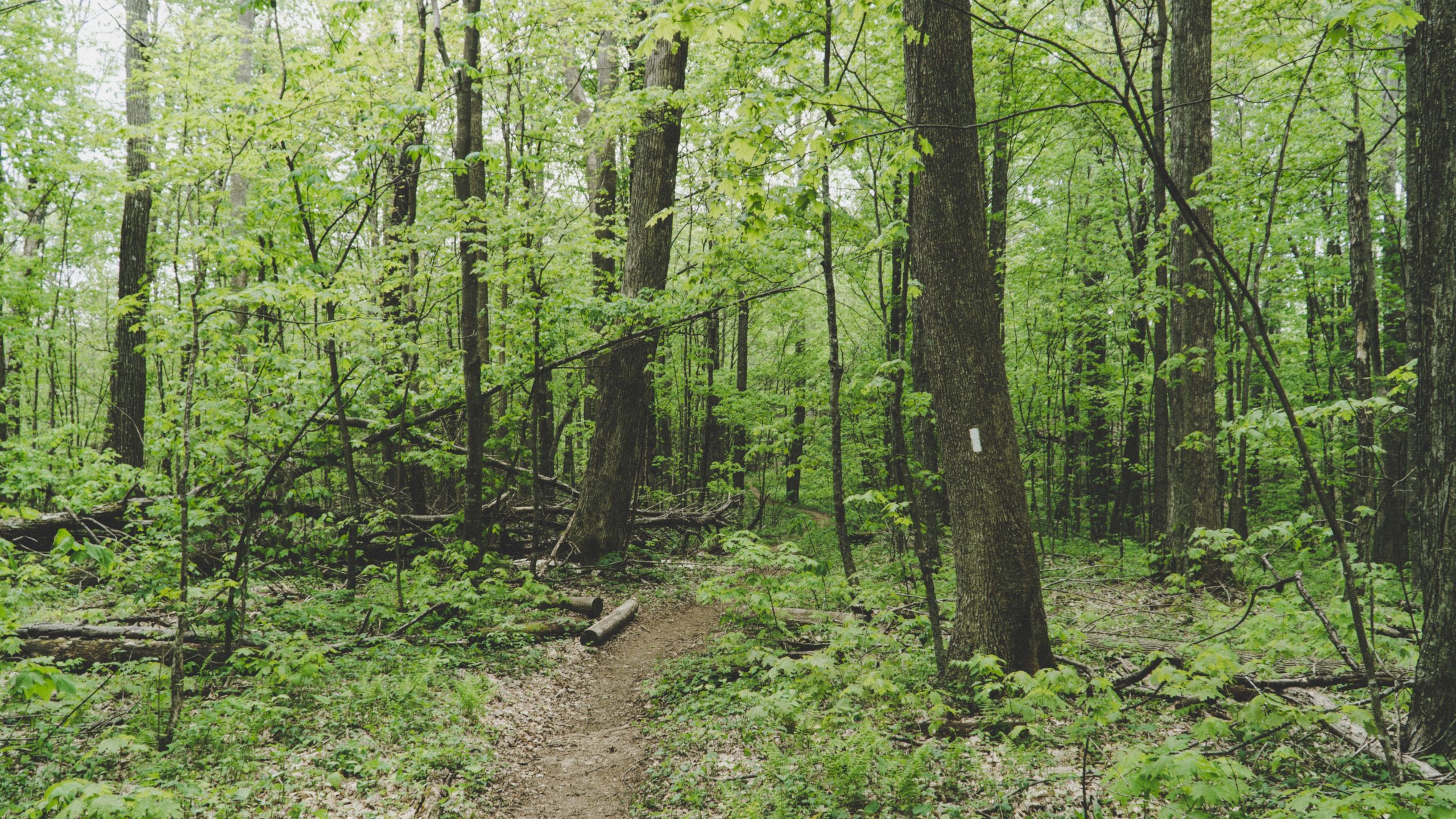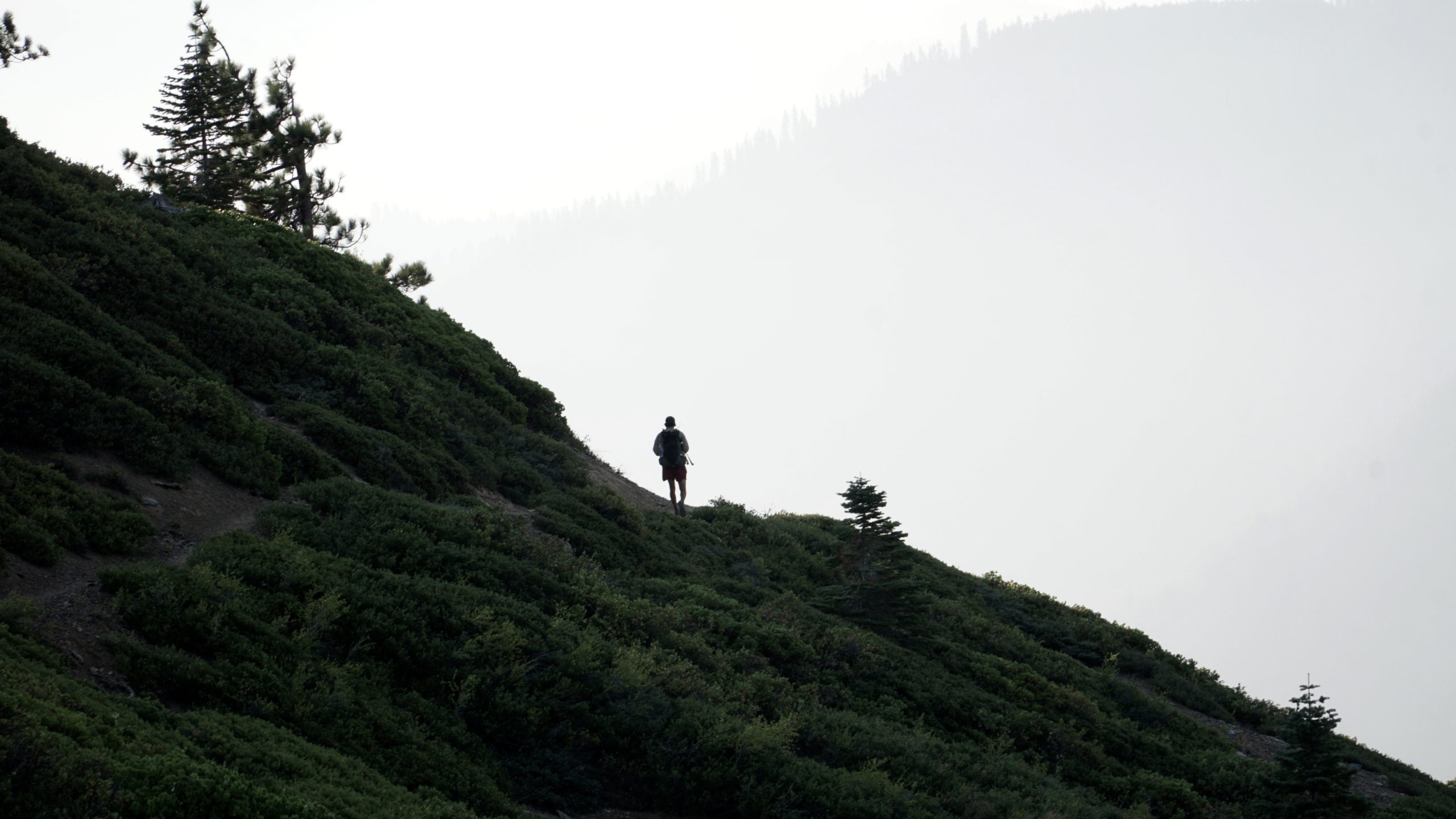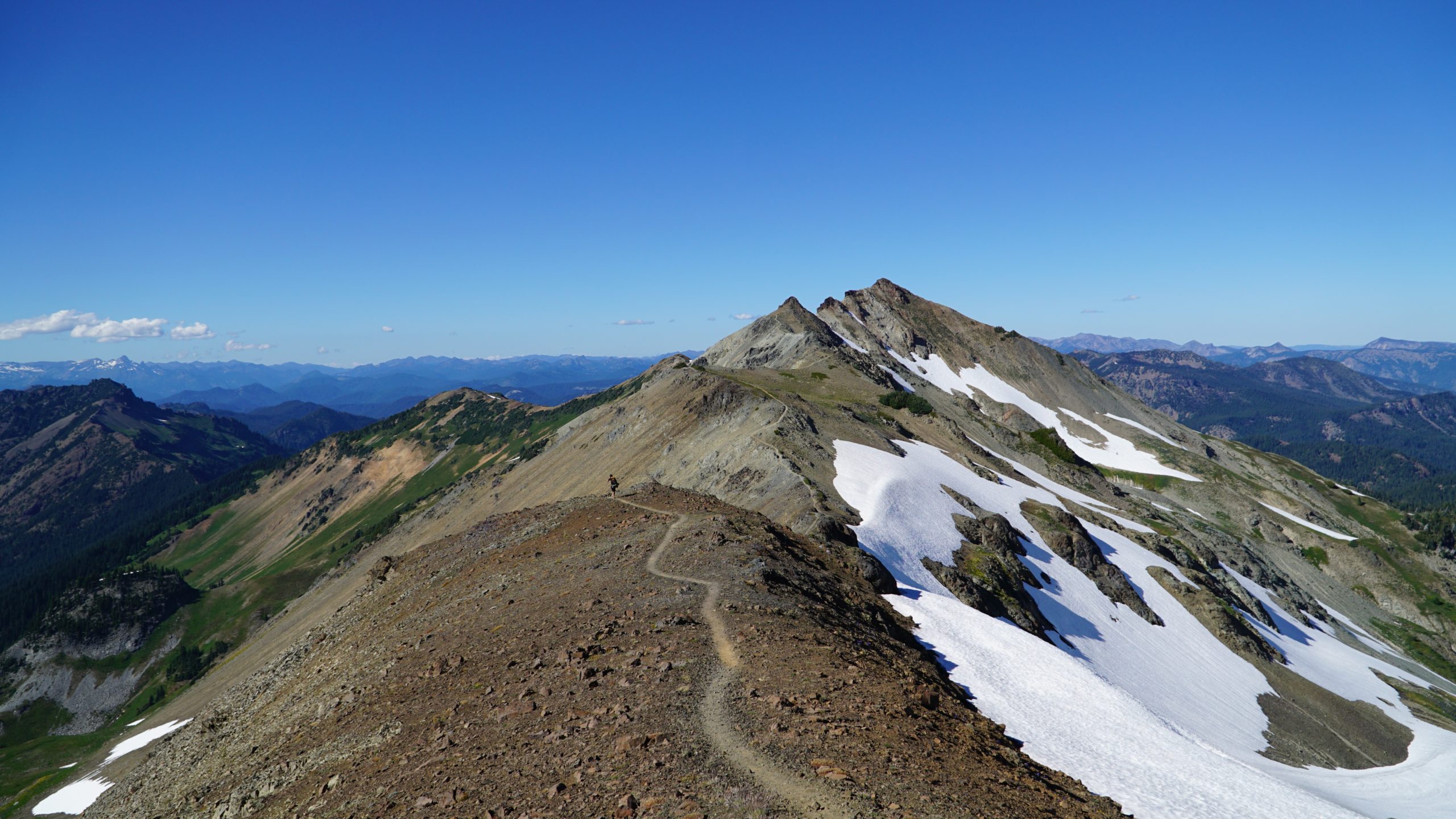6 All-Too Common Backpacking Myths That Need to Die
You might have thought backpacking was just a straightforward way to unplug and connect with nature, but no! It is a lifestyle rife with controversy and seething with scandalous misinformation. OK, so maybe I’m overstating things a bit, but still.
Nearly every backpacker has gnashed their teeth over these pervasive misunderstandings about the way we do things out here. (“No, Helen, I do not think I should bring a Bowie knife up Half Dome this time around, but thank you for the suggestion.”) Here are six of the most maddening backpacking myths that we would very much like to kill with fire.
6 All-Too Common Backpacking Myths That Need to Die
1. “You’re killing your joints with all that walking!”

Photo via Emily Hayes.
When I talk about my passion for long-distance hiking, people sometimes express concern for my health. Surely all that walking—with a heavy pack no less!—is hell on your joints, they worry. About three minutes into the conversation, they’ll start dropping subtle hints that I should probably drop the whole backpacking schtick altogether. For my health. Maybe take up a safer hobby, like knitting*.
While backpacking can be rough on your muscles and joints (injuries were the most common reason hikers got off the AT in our 2021 thru-hiker survey), modern ultralight gear and judicious use of trekking poles help take the pressure off. The key is to ease into hiking and listen to your body. Don’t be afraid to slow down, take a break, or change up your gear if you’re hurting. And for the love of whatever god you pray to, be cautious on steep downhills.
Backpacking is great exercise, which, contrary to popular belief, is actually good for your health. Studies suggest that load-bearing exercises like hiking with a pack improve your bone density in the long run, to say nothing of the muscle strength and cardiovascular fitness you’ll build.
With proper footwear, trekking poles, lightweight gear, regular stretching, and the ability to exercise restraint, there’s no reason backpacking should be detrimental to your long-term health. Quite the opposite, in fact.
*Disclaimer: No offense to knitting! I love a good, clean stockinette stitch as much as the next guy.
READ NEXT – 7 Exercises to Build Strength and Stability for Hiking
2. The trail is dangerous for solo women.
I read a listicle of solo female hiking safety tips the other day that had me half-convinced that my next solo effort would lead to my inevitable, gory demise and brutal axe murder. Could something terrible happen to a woman alone on the trail? Of course it could. Sadly, that possibility always exists, which is why situational awareness is vital.
Even so, I feel far safer hiking alone than walking the streets of a crowded city alone at night. When people talk about dangers to solo women hikers, they often are talking about dangers from fellow humans. In reality, most of us come into more frequent contact with two-legged varmints in our day-to-day lives. Encountering fewer people on the trail means you are statistically at much lower risk.
And while the dangers of getting lost or injured or running afoul of wildlife are real (often overblown, but definitely real), solo women are at no greater risk in this department than any other singleton hiker.
Moral of the story: Of course you should weigh the risks to your safety when you’re considering hiking solo, regardless of your gender. But I would encourage you not to let fear hold you back from the life you want. Put your fears in a reasonable context, take steps to adequately plan and prepare for your journey, pack your pepper spray, and go have the time of your life.
The Appalachian Trail Conservancy has a great list of sensible hiking safety tips, most of which can be applied to any trail.
READ NEXT – Examining the Real Numbers Behind Violent Instances on the Appalachian Trail
3. You have to be rich to backpack.

Photo via Nadia Fenay.
So, yeah. Backpacking gear is expensive, and even if you have it, you probably need a car, a plane ticket, or some other means to get to the trailhead. Not to mention time off work to peace out to the woods. There is undoubtedly a certain amount of privilege involved in being able to go backpacking in the first place, and it shows in the demographics of most long trails (for instance, our 2021 AT survey respondents were overwhelmingly white and college-educated).
That being said, it’s very possible to thru-hike on a shoestring budget by purchasing used gear, opting for a minimalist setup that foregoes expensive luxury items, making full use of hiker boxes, and avoiding the expensive “town vortex” of hotels and restaurants. It isn’t easy, and it isn’t the hike everyone would choose, but it certainly can be done.
If you don’t have the flexibility to take six months off, you may still be able to squeeze in a few overnighters and long weekends around your work schedule. For those who don’t own cars, accessibility to remote trailheads is a major issue for which I can’t offer a perfect solution. Many communities have outdoor clubs that sometimes carpool to trailheads in exchange for gas money—less than ideal, but a place to start looking if you’re determined to get out there.
Interestingly, the people who often struggle the most with affording a long-distance hike are actually often those with more resources in the civilized world. If you have few possessions or financial entanglements, it’s relatively straightforward to abscond to nature for a few months. The challenges multiply if you have a mortgage and a car payment to keep up with while you’re out of work for six months.
4. All backpackers are minimalists.
In direct counterpoint to everything I just said in the paragraphs above, one has to admit that backpackers can be pretty dang materialistic. I am a self-described minimalist who takes aggressive pleasure in judging people who love to shop and accumulate stuff. I am also one person who owns three of every Big Three item, four different sun shirts, and burns through two to five pairs of trail runners per year. But who’s counting?
I’m not saying every backpacker is closeted consumer scum like me, but there’s no denying that the outdoor industry is an unstoppable money-making machine, so I can’t be the only one. And in light of the ultralight gear craze, hikers are forking over more cash than ever on gear that’s designed to save you mad weight for a few years before snapping, tearing, melting, or otherwise disintegrating and going to the landfill.
What can we (OK, fine, what can I) do about this? Quit obsessing over the latest and greatest gear upgrades, take better care of the gear I have, and when I do need to replace it, favor brands that balance weight savings with durability (because UL does not have to be fragile).
READ NEXT – Zero-Waste Thru-Hike of the Appalachian Trail
5. Backpacking Is SO MUCH BETTER than Car Camping

Looks pretty darn nice to me. Photo by Laura Pluth on Unsplash.
But is it, though? I remember hiking through Lewis Mountain Campground, a front country campground in Shenandoah National Park, during my AT thru-hike and absolutely burning with envy over the spacious tents, elaborate meals, and general good hygiene of the car campers there.
I love backpacking, but honestly, car camping is pretty amazing too. You still get to sleep under the stars and day hike every day if you want, but you also get to change into clean clothes occasionally and eat a hot dinner that includes actual fresh vegetables. When you wake up in the morning, you get to linger over breakfast, and if you don’t feel like hiking that day, you don’t have to! Amazing.
I’ll never give up backpacking, but to all you day hikers and car campers out there: I applaud you. You guys have clearly cracked the code.
READ NEXT – Car Camping Gear for Every Budget
6. Thru-hiking is a vacation.

The Human-Nature Hostel in Roxbury, ME offers reiki and massage therapy. But trust me, thru-hiking is NOT A VACATION, people. Tell your friends.
I mean, yes, thru-hiking provides an extended break from the working world for those lucky enough to attempt it. But while it’s certainly a volunteer activity, I just don’t think “vacation” really captures the spirit of the endeavor.
OK, sure, it’s tough to argue with the vacation-y barbecue vibes of a really excellent hiker feed, and anything other than laundry that happens within town limits is generally a party, and yes, there are some hostels on the AT that offer massage therapy and the like. But other than that, it’s very grueling stuff, honest.
Completing a long trail is a major undertaking. It requires planning, commitment, and a high level of grit. It’s hard work and not always fun in the moment.
Many thru-hikers list their long trail achievements on their resumes during job applications. Not only does this explain long absences from the world of paid work, but it says something about the person’s character.
So while thru-hiking is (for many) a once-in-a-lifetime chance to take a step back from the routines of the working world, “vacation” is a bit of a misnomer. Maybe we should coin a new term. “Trek-cation?” “Endurance sabbatical?” “Character-building walkabout?” I think I’ll just stick with “thru-hike” and let the term speak for itself.
READ NEXT – Why “Embrace the Suck” Needs to Die
Final Thoughts
Until you hit the trail for your first backpacking trip, it’s difficult to know what it will actually be like. And once you do get out there, it might be completely different from what you were expecting. Ultimately, everyone’s experience will be unique: the only way to truly distinguish backpacking myth from fact is to get out there and try it for yourself.
Featured image: Graphic design by Chris Helm.
This website contains affiliate links, which means The Trek may receive a percentage of any product or service you purchase using the links in the articles or advertisements. The buyer pays the same price as they would otherwise, and your purchase helps to support The Trek's ongoing goal to serve you quality backpacking advice and information. Thanks for your support!
To learn more, please visit the About This Site page.





Comments 10
“closeted consumer scum” hahahaha – love it – me too. I am currently in withdrawal but expect I’ll succumb next year and buy something I “need”……
“There is undoubtedly a certain amount of privilege involved in being able to go backpacking in the first place, and it shows in the demographics of most long trails (for instance, our 2021 AT survey respondents were overwhelmingly white and college-educated). ” End quote. This is your conclusion? Gotta call BULLSHIT on this one. Maybe I can go on a thru hike because I sacrificed some years to get a degree, job, life , family and all the blessing’s that come with it. Instead of what so called non privleged did. Mostly dealing drugs and going to prison and having welfare babys. F**K off. Meanwhile, I’m gonna go enjoy some time in white privlege town………
I am pretty liberal and have been involved in backpacking since the 70s. I call bullshit on the “White Privlege” line. Thats just pandering…. Modern equipment is insanely expensive thanks to the marketing industry. But just like back in the 70s, its a form of recreation people with extremely modest incomes can afford. I did it when I was a minimum wage worker – just as I went rock climbing. $0.25 packets of Ramen Noodles, used gear, 10 mil plastic sheeting for a tarp instead of a tent.. worked great. Is basketball a “Privledge Activity” because tennis shoes can cost $150 – along with the rest of the kit thats supposedly reqired?
WOW!!!
Joe, you’re an idiot! And, I’m quite sure, are also a white male. Privileged? FOR SURE!!
However, I don’t know you so I’m not going to make assumptions and reduce you to the stereotypes of the “privileged white male.” You may be a pretty good person or you may be a giant douche!
You are, definitely, an idiot! (Statements about drug dealing and welfare babies make that clear!) But, the great thing about being an idiot is that it doesn’t have to be permanent…you can change that whenever you want! Best of luck with whatever you choose…
Kelly Floro’s articles are great. She does not get wrapped up in some overly pure definition of backpacking. This helps to encourage more people to get out on the trail. I have slowly accumulated some good gear over the years, but I’m just as happy to see someone giving it a try with a Walmart sleeping bag and an old external frame pack. They are out there doing it and seeing things that many people would never get to witness. Thru hikers should not look down on section hikers, backpackers should not look down on car campers, and car campers should not look down on day trippers piling into the mini van. Get more people enjoying the outdoors so that resources continue to flow into our parks.
I worked several projects as a paid Landscape Designer while simultaneously engaged in AT, PCT, CDT, BMT Figure 8 , and Pinhoti Tr thru hikes. While on those AT, PCT NOBO and CDT SOBO thru hikes I also volunteered time at various Botanical Gardens and doing trail construction and maintenance. I also find it fortunate being able to connect my other careers as a Horticulturalist, Naturalist, Landscape Contractor, and Arborist to thru hiking learning flora, fauna, geology, forestry, ecology, arboriculture, etc.
The idea LD backpacking has to preclude “work” or can’t further a career is inaccurate.
It is also a mistake to assume LD backpacking is an escape from commitment, discipline, and responsibility. As has been said, wherever you go there you are!
Hi Kelly. Good article, I get your point of view. Me, Im a Va section hiker. I can verify Va isnt flat. Logged in about 1200 miles of Va trails to include plenty of AT.
Being tailored to day and weekend trips is a different but not too much equipment wise. Had a two day expand and was glad to have packed for a week. Gear choices are a matter of what you plan to do, buy the best equipment you can afford and prepare physically and mentally
Keep after it Kelly
Agreed: Backpacking has better views; car camping has better food. Both are good.
Perspective is key. On the whole safety concern, indulge my story telling. Once upon a time, I regularly white watered the Potomac through MD/VA and into Washington, DC. I cannot tell you how many people remarked on how dangerous that was. They seemed astounded, flabbergasted that anyone would engage in such risky behavior. At the time, I recall that a grand total of five deaths were reported involving “boating” that stretch of the Potomac and those largely involved people mistaking themselves for superheroes and attempting to paddle over a dam. And the perspective of the people casting dispersions on us lunatics? Most of them regularly drove the Washington Beltway and the other roads in the area. I do not know the numbers, but I imagine any way you count (total deaths, deaths per mile, deaths per number of drivers) the driving with which they were comfortable was far more risky. Also certainly less rewarding from my perspective. Yes, the common follow up when bringing up his retort was that I didn’t have to canoe/kayak and they had to drive. Is that so?
So. Perspective. What is risky? What is acceptable risk? What is work? What is vacation? What is expensive? What do you include in calculating expense? Ultimately, the question is, what is life all about… from your perspective?
In 2011 I did a thru-hike after I retired and I continue do section every year. I’ve also hiked all the connecting trails so I’ve hiked from Key West to Katahdin; additionally I’ve done about half of the MST, Glacier National Park and the Camino de Santiago. While it can be expensive to ‘gear-up’ the first time, the expenses after that are more of what you would like to have vs what you need. I am using my original tent – Lightheart Gear – and my original sleeping bag, which I paid $100 at an REI sale. Most everything I hike with is original. I have replaced my trekking poles as I seem to be very rough on them, however, the ones I have now, Leki Corklite, have been with me at least 4 years. I have replaced stuff sacks and boots. I did buy a new backpack about 6 weeks ago, my original Granite Gear “with I dearly loved” was totally worn out. – I wear my original hiking pants….my point is you can spend a lot of money on equipment or you can take care of what you have and use it for a long time. When you need/want something new sell your used equipment – there are lots of places on line to do so. What you want to do and what you are able/capable of doing are not the same thing. Doing a thru-hike is not a privilege or a right – you may need to wait until you retire as I did, or save up for a few years, or do section hikes. Making statements about thru-hiking being for ‘rich’ or ‘elitist’ people is crap. You do not need a lot of money to do a thru-hike. Yes, you can spend a lot of money but I can pretty much guarantee you – it is not your equipment that will get you to Katahdin. It is your attitude.